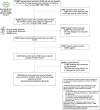Prenatal risk factors for child executive function at 3-5 years of age: the roles of maternal mood, substance use, and socioeconomic adversity in a prospective cohort study
- PMID: 39465362
- PMCID: PMC11514844
- DOI: 10.1186/s12887-024-05113-2
Prenatal risk factors for child executive function at 3-5 years of age: the roles of maternal mood, substance use, and socioeconomic adversity in a prospective cohort study
Abstract
Background: A growing body of literature links prenatal mood and substance use to children's cognitive and behavioral development. The relative contribution of these risk factors on children's executive function (EF) in the context of socioeconomic adversities needs further evaluation. To address this gap, we investigated the role of prenatal maternal anxiety and depression on childhood EF, specifically inhibitory control and working memory, within the context of socioeconomic adversities and prenatal substance use. We hypothesized that higher maternal mood symptoms, higher persistent prenatal drinking and smoking, and lower socioeconomic status would be associated with lower EF skills during early childhood.
Methods: We used data from 334 mother-child dyads followed prospectively through pregnancy and the offspring's childhood. Prenatal maternal depression and anxiety were assessed via standardized questionnaires. Prenatal alcohol and tobacco consumption were assessed via a timeline follow-back interview. The EF touch battery assessed child inhibitory control and working memory at 3-5 years of age (4.76 ± 0.58 years, 171 females). Separate linear regression models were used to estimate the association of prenatal tobacco, alcohol, anxiety, and depression exposure with our two components of child EF, inhibitory control and working memory, while adjusting for gestational age, sex, and age at assessment. The following variables were also included as covariates: maternal educational achievement, employment status, parity, and household crowding index.
Results: Children of mothers with high trait anxiety scores had reduced inhibitory control compared to children of mothers without trait anxiety or depression (β = -0.12, 95% CI:-0.22,-0.01). Children of mothers in the moderate to high continuous smoking group showed lower inhibitory control (β = - 0.19, 95% CI:-0.38,-0.01) compared to children of mothers in the none smoking group. Additionally, lower maternal education and higher household crowding were each associated with reduced inhibitory control. We found no significant association between prenatal maternal depression, anxiety, or socioeconomic factors with working memory.
Conclusions: These results underscore the need for comprehensive context-specific intervention packages, including mental health support for women to promote healthy inhibitory control development in children.
Keywords: EF touch battery; Executive function; Prenatal alcohol and tobacco exposure; Prenatal anxiety; Prenatal depression; Socioeconomic adversity.
© 2024. The Author(s).
Conflict of interest statement
The authors declare no competing interests.
Figures




References
-
- Power J, van IJzendoorn M, Lewis AJ, Chen W, Galbally M. Maternal perinatal depression and child executive function: A systematic review and meta-analysis. J Affect Disord. 2021;291:218–34. - PubMed
-
- Kim YH. Korean mothers’ alcohol consumption trajectories from childbirth to 6 years postpartum and children’s executive function difficulties at first grade. Soc Psychiatry Psychiatr Epidemiol. 2020;55(4):497–506. - PubMed
-
- Rasmussen C. Executive Functioning and Working Memory in Fetal Alcohol Spectrum Disorder. Alcohol Clin Exp Res. 2005;29(8):1359–67. - PubMed
MeSH terms
Grants and funding
LinkOut - more resources
Full Text Sources
Medical
Miscellaneous

